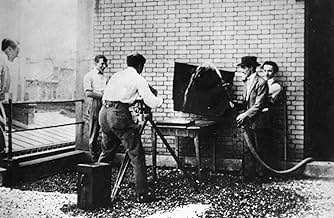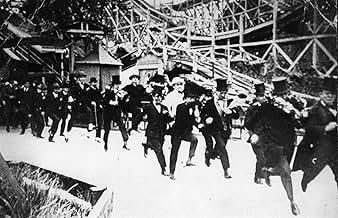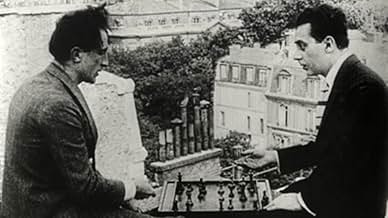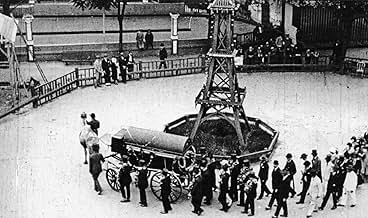Entr'acte
- 1924
- 22min
CALIFICACIÓN DE IMDb
7.3/10
4.3 k
TU CALIFICACIÓN
Agrega una trama en tu idiomaAn absolute dada movie. Somebody gets killed, his coffin gets out of control and after a chase it stops. The person gets out of it and let everybody who followed the coffin dissapear.An absolute dada movie. Somebody gets killed, his coffin gets out of control and after a chase it stops. The person gets out of it and let everybody who followed the coffin dissapear.An absolute dada movie. Somebody gets killed, his coffin gets out of control and after a chase it stops. The person gets out of it and let everybody who followed the coffin dissapear.
Inge Frïss
- La ballerine
- (as Mlle Frïss)
Man Ray
- Un joueur d'échecs
- (as Man-Ray)
Marcel Achard
- Un homme qui suit le corbillard
- (sin créditos)
Georges Auric
- Un homme qui suit le corbillard
- (sin créditos)
Georges Charensol
- Un homme qui suit le corbillard
- (sin créditos)
Georges Lacombe
- Un homme qui suit le corbillard
- (sin créditos)
Roger Le Bon
- Un homme qui suit le corbillard
- (sin créditos)
Jean Mamy
- Un homme qui suit le corbillard
- (sin créditos)
Rolf de Maré
- Un homme qui suit le corbillard
- (sin créditos)
Erik Satie
- Un homme qui charge le canon
- (sin créditos)
Pierre Scize
- Un homme qui suit le corbillard
- (sin créditos)
Louis Touchages
- Un homme qui suit le corbillard
- (sin créditos)
- Dirección
- Guionistas
- Todo el elenco y el equipo
- Producción, taquilla y más en IMDbPro
Argumento
¿Sabías que…?
- TriviaThe ballet "Relâche" ("Theatre Closed") premiered at the Théâtre des Champs Elyseés in Paris on December 4, 1924. Based on a book and with settings by Francis Picabia, it was a ballet in two acts commissioned and staged by the Ballets Suédois of Rolf de Maré, with choreography by Jean Börlin. As the title "Entr'acte" implies, this film was shown between the two acts, with music by Erik Satie.
- ErroresObvious stand-in for the close-up of Rolf de Maré getting kicked in head, which sends him (via reverse motion) flying back into the end title. The "kick" itself is clearly achieved through reverse motion.
- Versiones alternativasThere is an Italian edition of this film on DVD, distributed by DNA Srl (2 Films on a single DVD). The film has been re-edited with the contribution of film historian Riccardo Cusin. This version is also available for streaming on some platforms.
- ConexionesEdited into Avant-garde Cinema (1960)
Opinión destacada
René Clair's "Entr'acte" is one of the pioneering films of the surrealist genre in cinema, which, from what I gather, is the attempt at bending reality and twisting all that we've come to know into something deeply strange but entirely mesmerizing. Heavy on its use of perverse or unique imagery and juxtaposition of images and sequences and frequently rejecting the conventions of linear, dramatic filmmaking, such surrealist filmmakers today, such as Quentin Dupieux and Terry Gilliam, focus on a wide-range or visual styles in addition to wacky, out-there humor that is sometimes funny because it doesn't make a bit of sense (otherwise known as "anti-humor").
When it comes to "Entr'acte," however, we have an intriguing piece of film on our hands, one that serves as an early film of the "dadaism" movement in art, where European artists, writers, poets, filmmakers, and theorists began to reject commonly- utilized devices in art of the time in favor of a more radical approach to their mediums. These often included the injection of leftist policies and believes, most specifically anti-war policies that began hitting their stride as World War II neared.
Just by watching the first few minutes of "Entr'acte," one can see that it has no desire at all to try and fit in with conventional artistic standards. It serves as a conglomerate of visuals from the dadaist period, many of which not making very much sense, but each provoking a genre-bending fascination amongst the audience. The opening scene itself is something to marvel at, showing two people firing a cannon from the top of a large building, while strangely-calming and infectious music is played in the background.
The film persists on, with numerous different visuals that were likely never before seen outside of this particular work. What's remarkable is that despite the film's age, scenes involving characters running in slow motion and then being sped up into running in fast-motion after a vehicle still hold a certain kind of power to them. Overall, there's a mesmerizing quality "Entr'acte" bears that is surprising to note seeing as it perfectly defines a film that was "the first of its kind."
Directed by: René Clair.
When it comes to "Entr'acte," however, we have an intriguing piece of film on our hands, one that serves as an early film of the "dadaism" movement in art, where European artists, writers, poets, filmmakers, and theorists began to reject commonly- utilized devices in art of the time in favor of a more radical approach to their mediums. These often included the injection of leftist policies and believes, most specifically anti-war policies that began hitting their stride as World War II neared.
Just by watching the first few minutes of "Entr'acte," one can see that it has no desire at all to try and fit in with conventional artistic standards. It serves as a conglomerate of visuals from the dadaist period, many of which not making very much sense, but each provoking a genre-bending fascination amongst the audience. The opening scene itself is something to marvel at, showing two people firing a cannon from the top of a large building, while strangely-calming and infectious music is played in the background.
The film persists on, with numerous different visuals that were likely never before seen outside of this particular work. What's remarkable is that despite the film's age, scenes involving characters running in slow motion and then being sped up into running in fast-motion after a vehicle still hold a certain kind of power to them. Overall, there's a mesmerizing quality "Entr'acte" bears that is surprising to note seeing as it perfectly defines a film that was "the first of its kind."
Directed by: René Clair.
- StevePulaski
- 6 abr 2014
- Enlace permanente
Selecciones populares
Inicia sesión para calificar y agrega a la lista de videos para obtener recomendaciones personalizadas
Detalles
- Tiempo de ejecución22 minutos
- Color
- Mezcla de sonido
- Relación de aspecto
- 1.33 : 1
Contribuir a esta página
Sugiere una edición o agrega el contenido que falta

Principales brechas de datos
By what name was Entr'acte (1924) officially released in Canada in English?
Responda





















